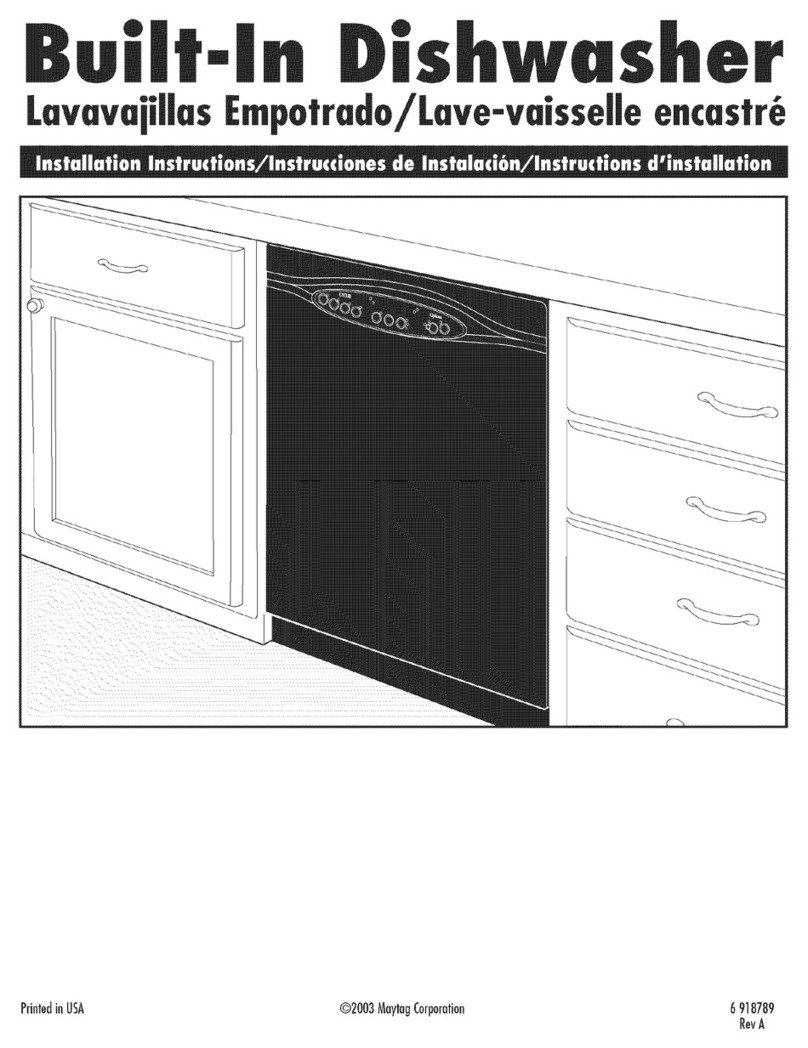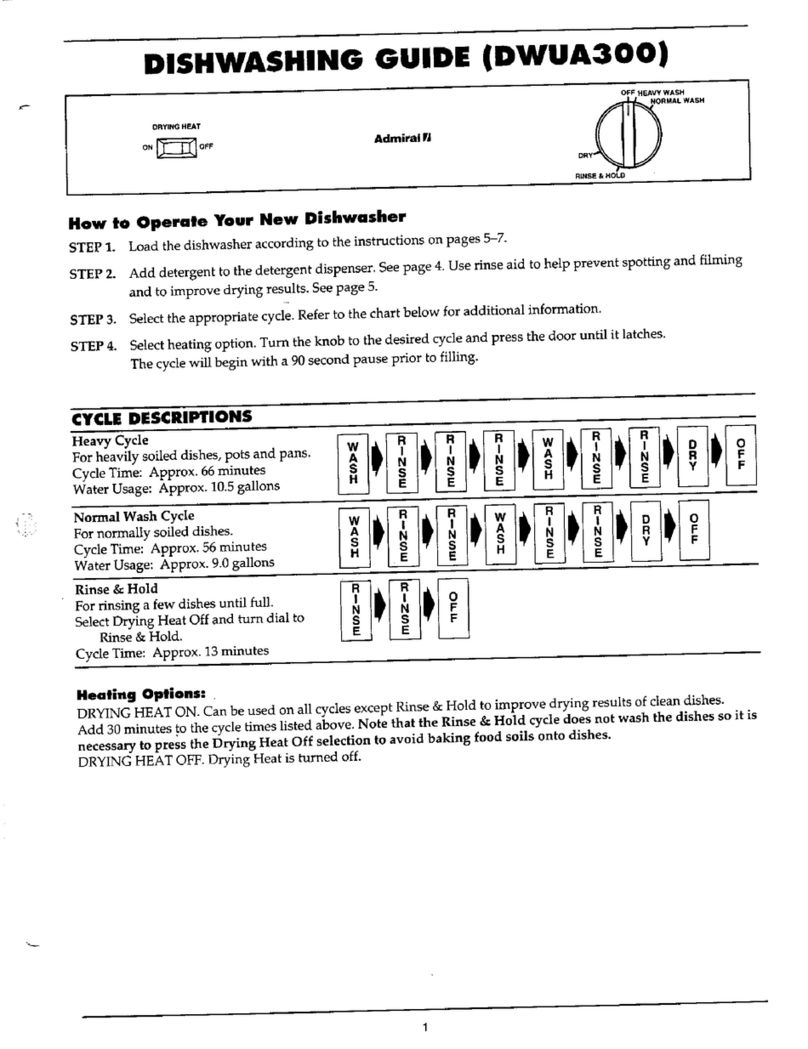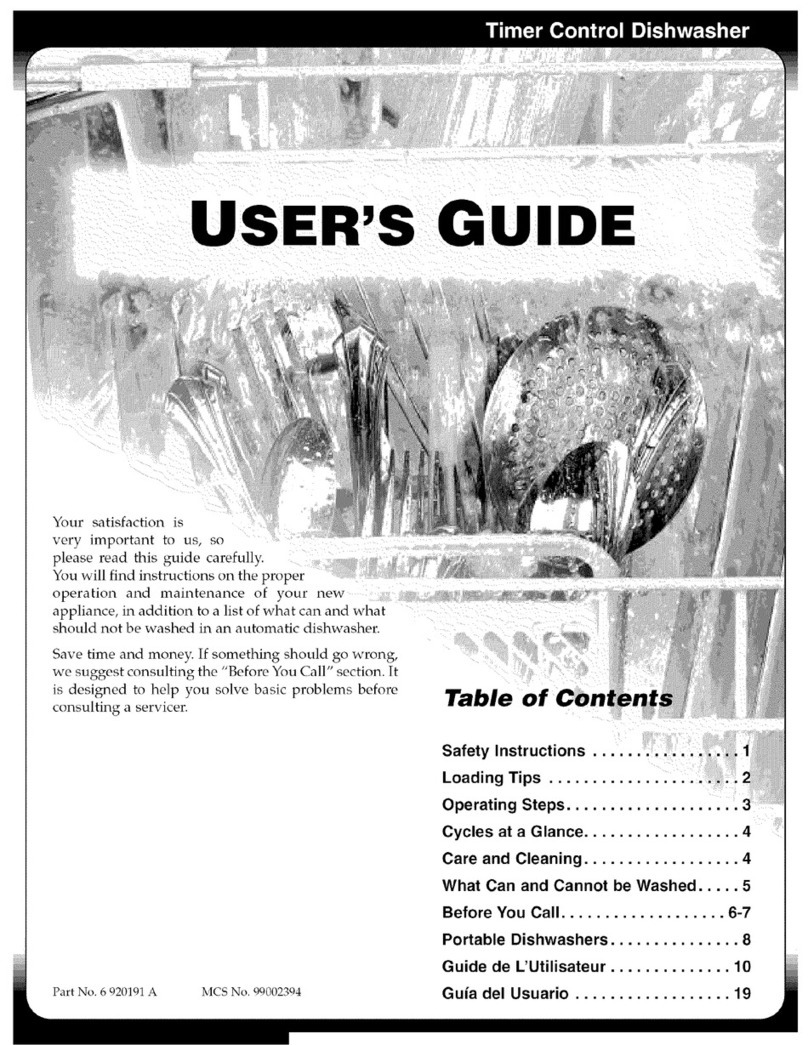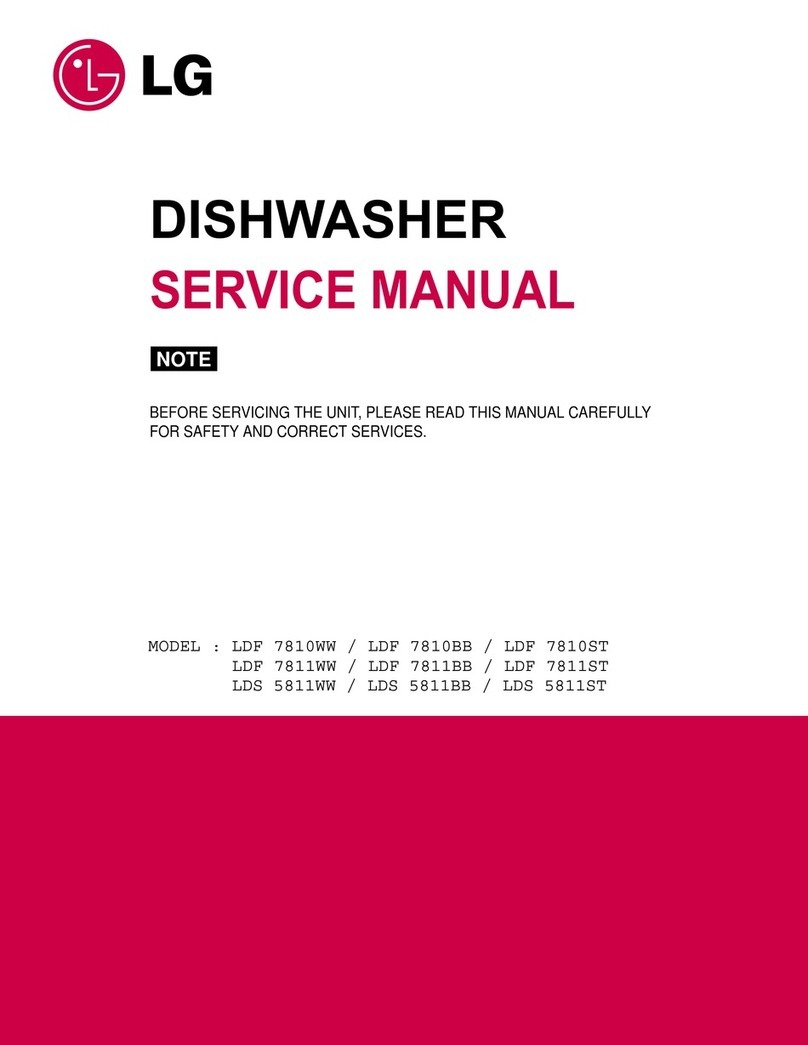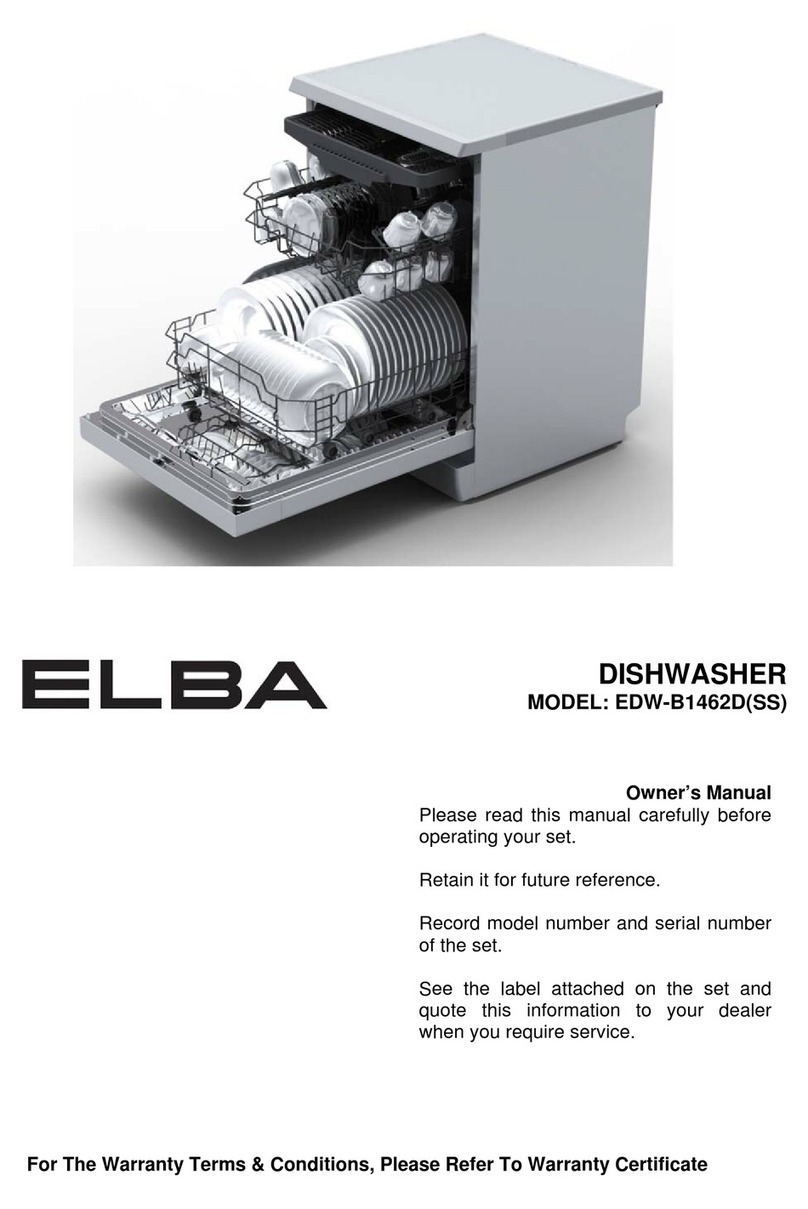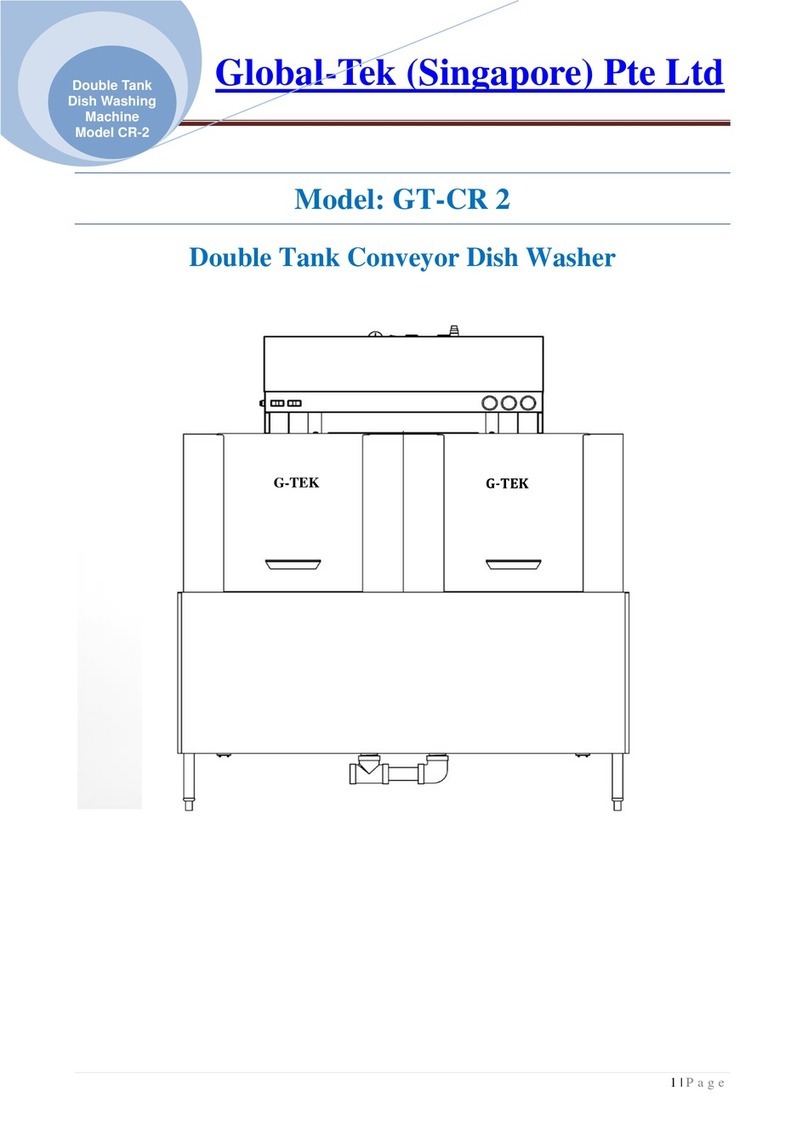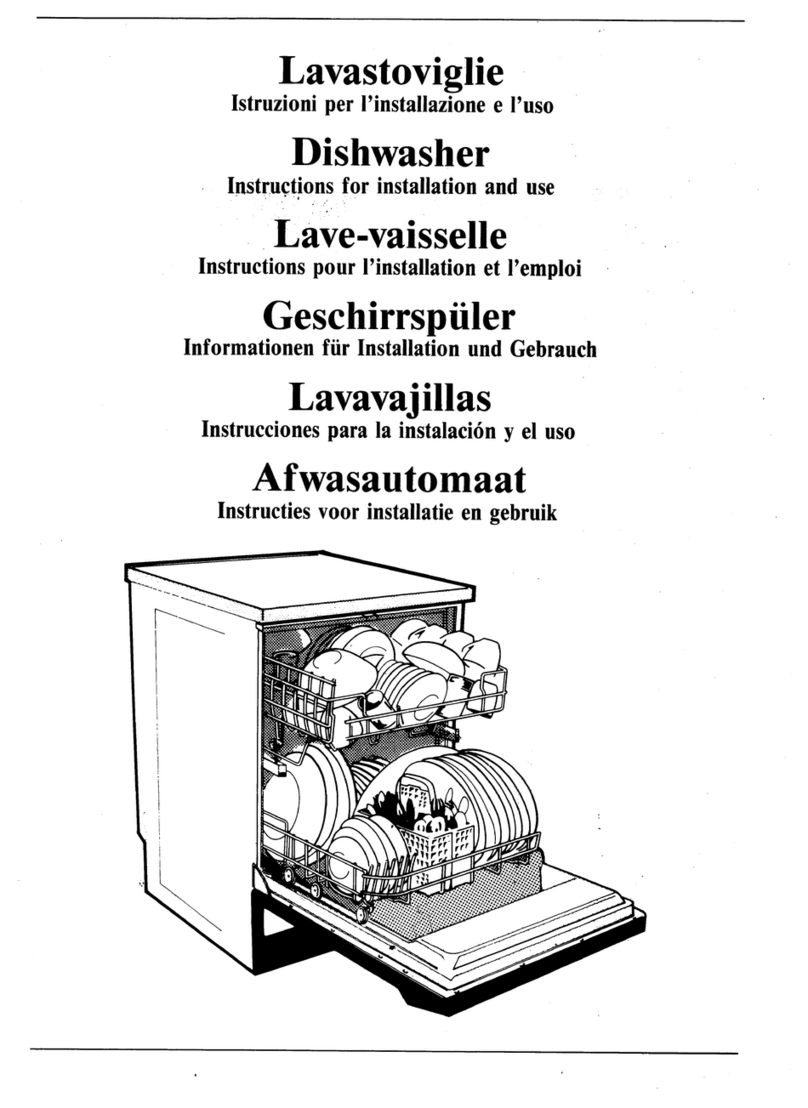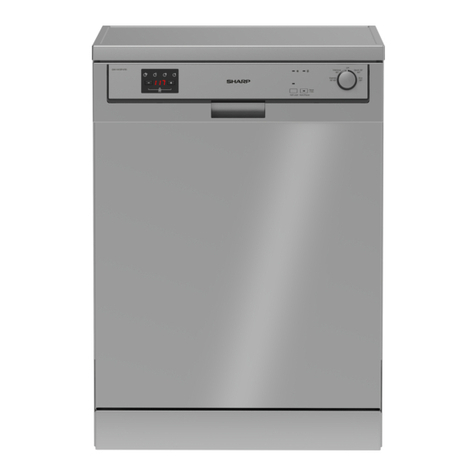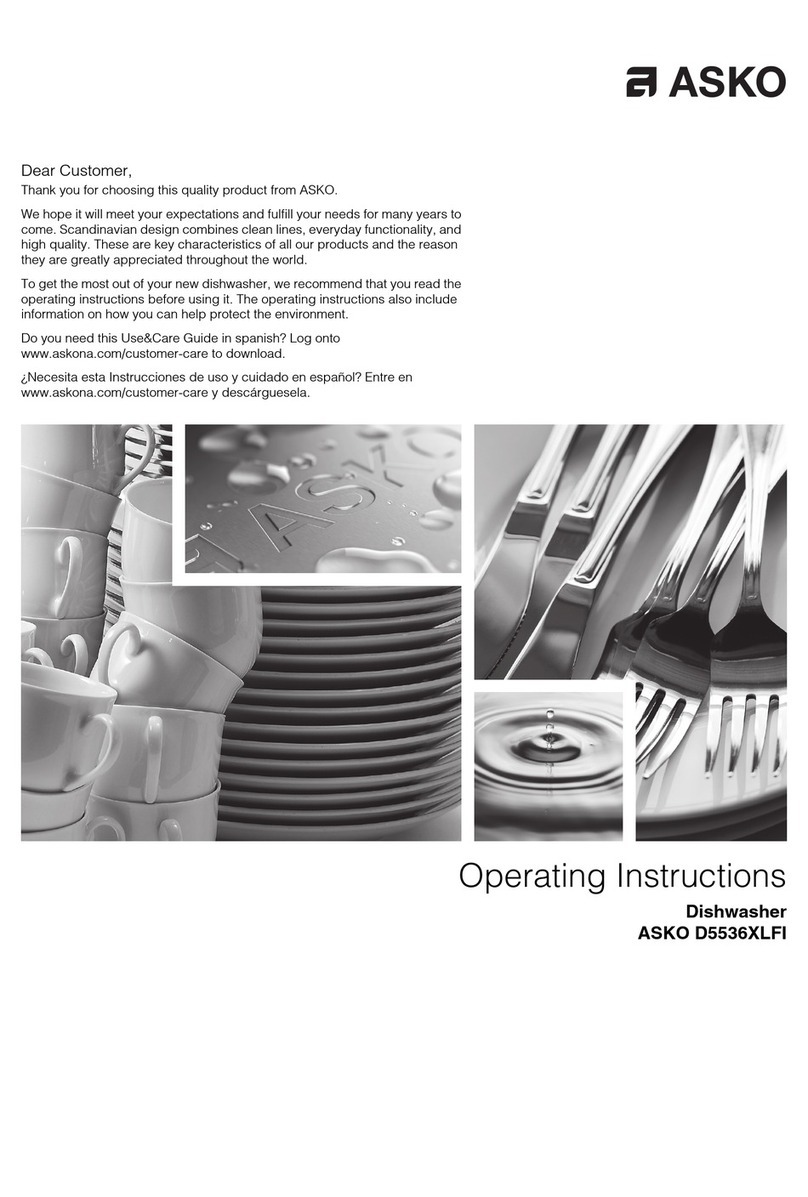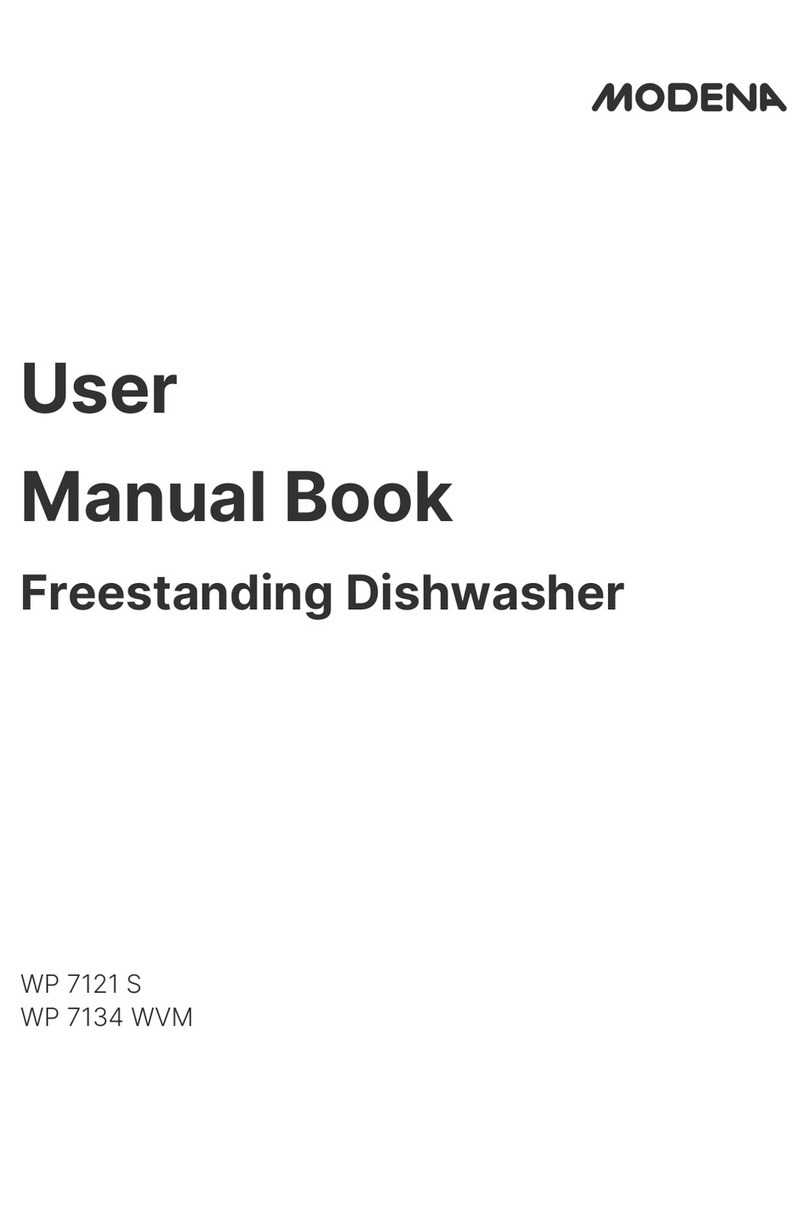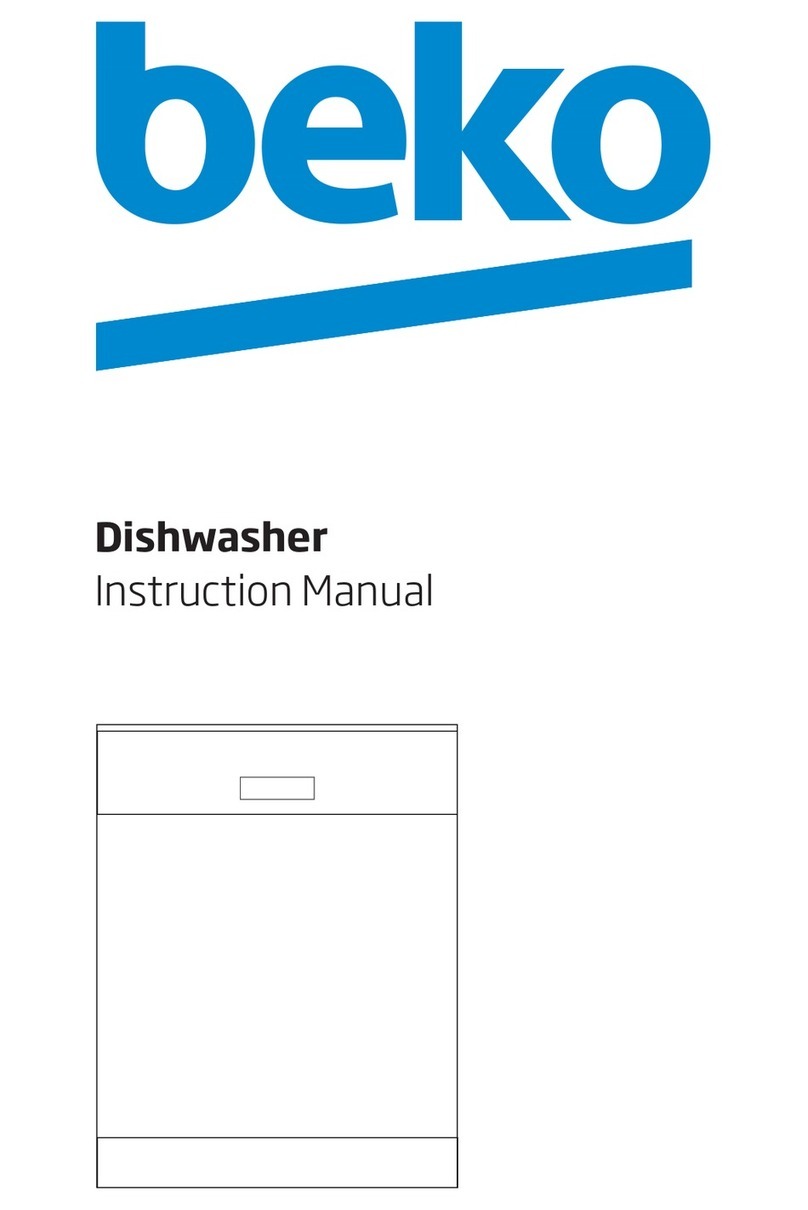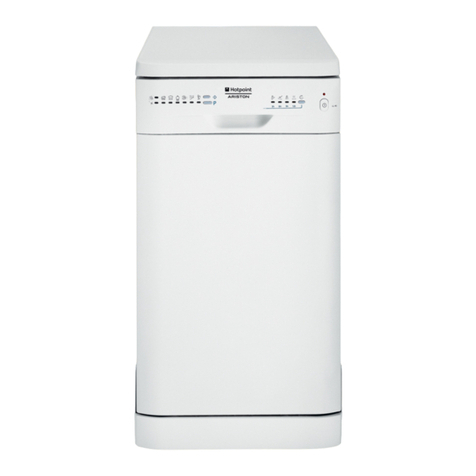Admiral DWD-1 User manual

Table of Contents
Safety . . . . . . . . . . . . . . . . . . . 1
Operating Tips . . . . . . . . . . . . . 2
Loading . . . . . . . . . . . . . . . . 2-3
Dishwasher Use . . . . . . . . . . . . 4
Cycles, Options
and Lights . . . . . . . . . . . . . . . 5-6
DWD-1
Use & Care Guide
®
Part No. 6 919192 A ©2004 Maytag Appliances Sales Co.
What Can &
Cannot be Washed . . . . . . . . . .7
Care & Cleaning . . . . . . . . . . . 8
Troubleshooting . . . . . . . . . 9-10
Warranty & Service . . . . . . . . 11
Guide d’utilisation
et d’entretien . . . . . . . . . . . . .12
Guiá de Uso y Cuidado . . . . . 24

1
DANGER – Immediate hazards which WILL result in
severe personal injury or death.
DANGER
WARNING – Hazards or unsafe practices which COULD
result in severe personal injury or death.
WARNING
CAUTION – Hazards or unsafe practices which COULD
result in minor personal injury or property damage.
CAUTION
Installer: Please leave this manual with this appliance.
Consumer: Please read and keep this manual for future
reference. Keep sales receipt and/or cancelled check as
proof of purchase.
Model Number ____________________________________
Serial Number_____________________________________
Date of Purchase __________________________________
If you have questions, call:
1-800-688-9920 (USA) and 1-800-688-2002 (CANADA)
1-800-688-2080 (U.S. TTY for hearing or speech
impaired) (Mon.-Fri., 8 am-8 pm Eastern Time)
In our continuing effort to improve the quality and perfor-
mance of our appliances, it may be necessary to make
changes to the appliance without revising this guide.
For service information, see page 11.
What You Need to Know About
Safety Instructions
Warning and Important Safety Instructions appearing in this
manual are not meant to cover all possible conditions and
situations that may occur. Common sense, caution and care
must be exercised when installing, maintaining or operating
the dishwasher.
Always contact your dealer, distributor, service agent or
manufacturer about problems or conditions you do not
understand.
Recognize Safety Symbols, Words, Labels
Products with a label have been listed with
Underwriter’s Laboratories, Inc. – those with a CSA tag have
been listed with Canadian Standards Association.
Nevertheless, as with any other equipment using electricity
and moving parts, there is a potential hazard.
1. Read all instructions before using the dishwasher.
2. Use the dishwasher only for its intended function.
3. Disconnect electrical power to dishwasher before
attempting to service.
4. To avoid electrical shock hazard, the sides and back
must be enclosed and the front panels must be
attached before electrical power is applied to the
dishwasher. Refer to the installation instructions for
proper grounding procedures.
5. Connect to a properly rated, protected and sized
power supply circuit to avoid electrical overload.
6. Children should never be permitted to operate, or play
in, with, or around this dishwasher.
7. To reduce the risk of injury when loading items to be
washed, sharp or pointed items should be located with
the handles up. Also, load sharp items so they are not
likely to damage the door seal.
8. Do not touch the heating element on the bottom of
the tub during or at the completion of a cycle. It will
be hot.
9. Use only detergents and rinse additives designed for a
residential automatic dishwasher. Never use soap,
laundry detergent, or hand washing detergent in your
dishwasher. Keep these products out of reach of
children.
10. Do not sit, stand on or abuse the door or dish racks of
the dishwasher.
11. Under certain conditions, hydrogen gas may be
produced in a hot water system that has not been
used for two weeks or more. Hydrogen gas is
explosive. If the hot water system has not been used
for such a period, turn on all hot water faucets and let
the water flow from each for several minutes. This will
release any accumulated hydrogen gas. As the gas is
flammable, do not smoke or use an open flame during
this process.
12. Do not wash plastic items unless marked “dishwasher
safe” or the equivalent. For plastic items not so
marked, check the manufacturer’s recommendations.
13. Do not tamper with controls.
14. To prevent accidental child entrapment and
suffocation risks, always remove the door to the
washing compartment when removing an old
dishwasher from service or discarding it.
15. Use caution when unloading the dishwasher. Dishes
will be hot if unloaded shortly after a cycle has
completed.
16. Certified residential dishwashers are not intended for
licensed food establishments.
Save These Instructions
for Future Reference
Check with the installer to make sure the appliance
has been properly grounded to avoid possible
electrical shock. Be sure you read the important
personal safety instructions before you use this
dishwasher.
WARNING
Important Safety Instructions
When using your dishwasher, follow basic
precautions, including the following:
WARNING
Safety

2
Before You Start
• Don’t prerinse. Simply scrape off any bones or
large food particles.
• If connected to a food waste disposer, make certain
the disposer is empty before starting the
dishwasher.
• Scrape off tomato-based food soils (see page 8).
• Remove certain foods such as mustard,
mayonnaise, lemon juice, vinegar, salt or dressings
from stainless steel flatware as soon as possible.
These foods may cause rusting and pitting if allowed
to remain in contact with the surface for an extended
period of time.
Operating the Dishwasher
1. After loading the dishwasher and adding detergent,
select the desired cycle by pressing the cycle select
pad until the light next to the desired cycle is
illuminated. Choose the desired options by pressing
the pads. The indicator lights for the selected cycle
and options will illuminate. To cancel an option
press the pad again.
2. To start a cycle, close the door until it latches then
press the START/Cancel pad once. After a pause,
the fill will begin. The display countdown (select
models) will flash until START/Cancel is pressed.
Note
• If START/Cancel is not pressed within 30
seconds of choosing your cycle, the dishwasher
will turn off.
The dishwasher remembers your last cycle so you
do not have to reset the cycle each time. To start
the dishwasher using the same cycle and options
selected on the previous wash, just press the
START/Cancel pad.
3. To cancel a running cycle, press the START/Cancel
pad once. The dishwasher will drain, then shut off.
To turn the dishwasher off without draining, press
the START/Cancel pad twice. To prevent
unplanned cycle or option changes, these selections
are “locked in” after 1 minute.
Note
•If the cycle select pad is pressed after the
controls have been “locked in”, the light above the
current cycle will flash three times.
Adding a Forgotten Item
For best cleaning, the forgotten item should be added
early in the cycle.
1. Grasp door handle and unlatch door without
opening completely. All lights will flash to indicate
that the cycle is suspended.
2. Wait for the water circulation to stop.
3. Open the door and add the item.
4. Close and latch the door. Lights will stop flashing
when the door is properly shut. After a slight delay,
the cycle resumes automatically at the point of
interruption.
Notes
•If the door is opened during a running cycle,
there may be up to a 30 second delay before the
dishwasher restarts after closing the door.
•Extended interruption of the wash cycle is not
recommended.
General Recommendations
(Rack features vary by model)
• Items can be centered behind a single tine or loaded
at an angle to maximize space.
• Avoid blocking or preventing the spray arms from
spinning freely. Do not allow items to extend beyond
the racks.
• Face soiled surfaces toward the center of the
dishwasher.
For best dishwashing results follow these guidelines to
determine the best arrangement for your items.
10 Place Setting Load
(Rack features vary by model)
Operating Tips
Upper Rack
Lower Rack

3
Upper Rack
Glasses, cups, stemware, light-weight plastics, plates,
bowls, pans, long-handled utensils etc. can be loaded
in this rack. Do not load glasses over the tines.
The Stack-Rack (select
models) on the right side
of the upper rack folds
up or down for loading
flexibility. Fold it down to
hold long-handled
knives, spatulas and spoons or short items like cups or
juice glasses. Fold it up for taller items like glasses,
bowls, plates, etc.
The edge of the Stack-
Rack (select models) is
designed to hold
stemware in place. Taller
stemware will fit better on
the right side as the upper
rack is deeper on this side.
The Cup Clips (select
models) located in the
center of the upper rack
can be used to hold
light-weight plastic items,
cooking utensils, knives,
etc. in place. Clip the
item between the tine
and the clip.
Lower Rack
A variety of items such as dinner plates, mixing bowls,
pots and pans and baking dishes can be loaded in this
rack.
Wider items can be placed along the left side and
back of this rack.
Utensil Basket
Removable Standard Utensil Basket
(style may vary)
For best cleaning results, prevent
items from nesting together by
placing some items in the basket
with handles up and some with
handles down. On models with
slotted covers, load knives, handles up and spoons and
forks handles down.
Be sure that thin, finely pointed items do not extend
through the basket. This could block the lower wash
arm.
Auxiliary Basket (select models)
Use this supplemental
basket in the upper or
lower rack for loading
miscellaneous items and
utensils. This is also a safe
place to load sharp knives
and pointed items.
Removing the Upper Rack
The upper rack can be removed when tall or oversized
items need to be loaded into the lower rack. Unload
the rack before removing it from the dishwasher.
To remove rack:
1. Roll the rack 1⁄3to 1⁄2of the way out.
2. To remove each plastic push tab rack stop from the
end of each track, push inward (toward the rack) on
the ridged area of the rack stop. The rack stop will
snap open and can be easily removed by pulling
straight out. Take care to support the track while
removing rack
stops.
3. Roll the rack all the
way out of the
track and remove
from the
dishwasher.
To replace:
• Reverse the above
procedure to replace the rack into the dishwasher.
Important
The dishwasher will not
operate correctly if the
wash arm is not aligned
with one of the water inlet
holes on back wall of the
dishwasher.
Loading
Push Tab
Rack Stop

4
Hot Water
For optimal cleaning and drying results, hot water
is necessary. The incoming water temperature
should be 120° F (49° C) to properly activate the
detergent and melt greasy food soils.
To check the incoming water temperature, turn on the
hot water faucet nearest the dishwasher and let it run
into a glass in the sink. Place a candy thermometer in
the glass and check the temperature once it has
stopped rising.
Detergent
Use a detergent designed specifically for use in an
automatic dishwasher. Be sure it is fresh. Store
granular detergent in a cool, dry place (not under the
sink).
Recommended Amount
Too little detergent results in poor cleaning, hard water
filming/spotting and poor drying. Too much detergent
can cause permanent etching/cloudiness.
The amount of detergent to use is determined by the
hardness of the water and soil level of the load. Refer
to the following chart for detergent usage
recommendations.
In extremely hard water conditions (13 grains per
gallon or more*), it is difficult to achieve good
results with any dishwasher. A mechanical water
softener may be necessary to improve water
quality, detergent effectiveness, and protect the
dishwasher parts from the damage that hard
water can cause.
Add recommended amount of detergent to each cup
as shown and close the detergent lid.
Do not use detergent with the Rinse Only (select
models) cycle. Leave the detergent lid open when
running Rinse Only (select models).
Rinse Aid
Regular use of a rinse aid improves drying,
reduces spotting and filming, and reduces
moisture left on the dishwasher interior.
An automatic rinse aid dispenser is located next to the
detergent cup.
The window next to the dispenser cap indicates when
the rinse aid reservoir needs to be refilled. When the
level of rinse aid is below the indicator marks and the
window is nearly clear, it is time to refill the dispenser.
Check the dispenser monthly.
To add rinse aid to the
dispenser, turn the cap
counterclockwise to open.
Remove the cap and pour
liquid rinse aid into the
opening. The amount of
rinse aid dispensed during
the cycle is adjustable by moving the lever inside the
reservoir area. For most water conditions use the
manufacturer recommended setting of “2”. Adjust it up to
the “MAX” setting for hard water. Set the lever anywhere
between these amounts as needed to get the best results.
Replace the cap and turn it clockwise to close.
*Your local water utility or state university extension service can tell
you the degree of water hardness in your area.
Dishwasher Use
6 tsp
6 tsp
7 tsp
6 tsp
6 tsp
7 tsp
8 tsp
Light Soil
Normal Soil
Heavy Soil
Light Soil
Normal Soil
Heavy Soil
All Levels
2 tsp
4 tsp
4 tsp
4 tsp
4 tsp
5 tsp
5 tsp
WATER
HARDNESS*
SOIL
LEVEL
PRE-WASH
DETERGENT MAIN WASH
DETERGENT
Soft (0-4 gpg)
Medium (5-9 gpg)
Hard (10-12 gpg)
Table of contents
Languages:
Other Admiral Dishwasher manuals
